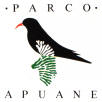|
|
|
|
|
|
|

|
7th
International Conference on Unesco Global Geoparks
38th EGN Coordination
Committee Meeting
Torquay
(United Kingdom), 26st -30th September 2016 |
|
|
|
|
|
|
|
PHOTO
CHRONICLE
|
|
|
On this
occasion, the Apuan Alps Geopark participated to the International
Conference on Unesco Global Geoparks for the first time. This biennial GGN
appointment has been chosen to present and enhance "Rains and Ruins", the
exhibition thought for reminding twenty years after the disastrous 1996
Flood in Versilia and Garfagnana. The presentation of this educational and
cultural event has been attended by an international audience during the
panel discussion on "Disaster Risk Reduction".
|
|
|
|
|
|
|
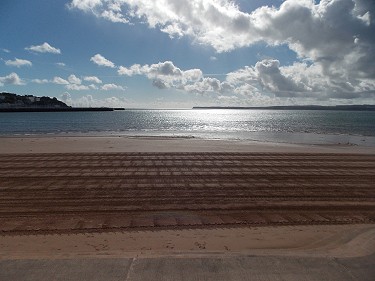
|
Sunday
25.09.2016
A
suggestive view
of Tor bay, in front of Torquay, on the south-east coast of Devon
county (England).
|
|
|
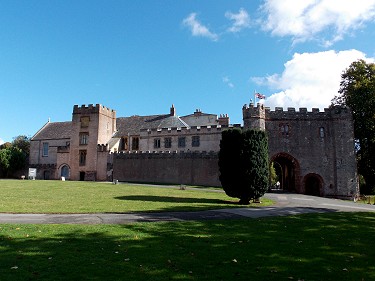
|
Sunday 25.09.2016
The most important
historic building in Torquay is Torre Abbey. It is located a short walk
from the Riviera International Conference Center.
This complex monument was founded in 1196 as a monastery for
Premonstratensian Canons and subsequently was modified for other uses.
The picture shows the
eastern side of Torre Abbey. From right to left, you can see the
gatehouse, scullery block and undercrofts.
|
|
|

|
Sunday 25.09.2016
The west side of the medieval cloister is still standing in Torre Abbey.
|
|
|
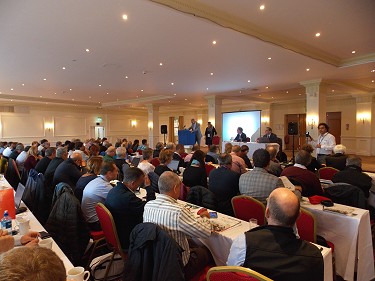
|
Monday 26.09.2016
The first day is entirely devoted to the Coordination Committee of
the European Geoparks Network.
The representatives of the 69 European Geoparks participate to this
event.
The location is inside the Imperial Hotel in Torquay.
|
|
|

|
Monday 26.09.2016
Nikolas Zouros (EGN and GGN Coordinator) sits at the chairman's table
together with Nick Powe (Director of Kents
Cavern prehistoric caves). |
|
|
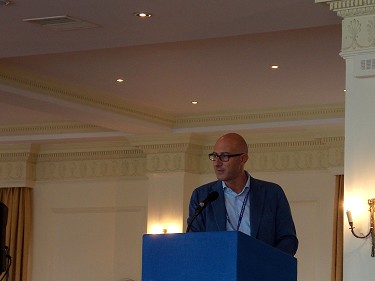
|
Monday 26.09.2016
Maurizio Burlando (Beigua Unesco Global Geopark) is the
chairman during the meeting section in the afternoon.
|
|
|
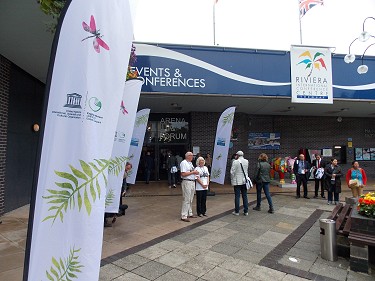
|
Tuesday 27.09.2016
Everything is ready for the opening ceremony in the Riviera
International Conference Center.
|
|
|
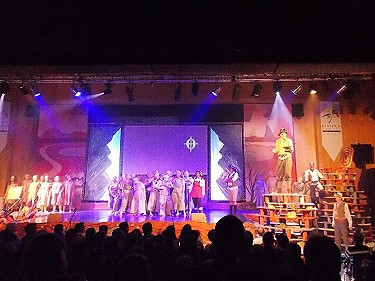
|
Tuesday 27.09.2016
The original performance "Earth Echoes", including dance, music,
song, story and drama, is offered to the guests and partners before the
Conference. |
|
|
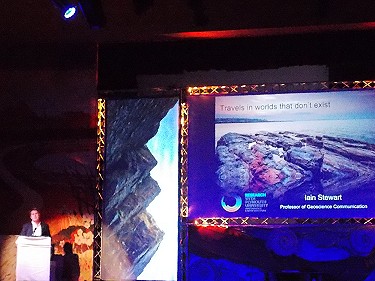
|
Tuesday 27.09.2016
Prof. Iain Stewart (Geoscience Communication - Plymouth University)
presents a high-level key note. He tells geology through "travels
in worlds that don't exist".
|
|
|
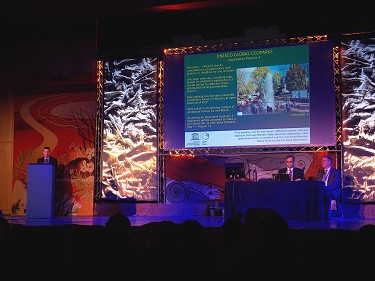
|
Tuesday 27.09.2016
Prof. Patrick McKeever is the official voice of Unesco in the Conference.
His speech summarizes the main aspects and contents of the Intenational
Geoscience and Geoparks Programme (IGGP).
|
|
|
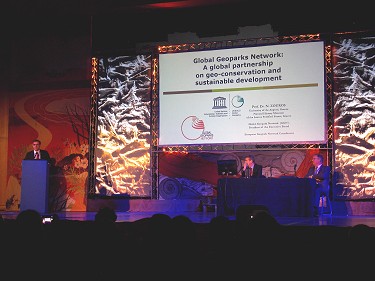
|
Tuesday 27.09.2016
The intervention of prof.
Nickolas Zouros
concludes the "key notes" session. The GGN President describes the
Geoparks activity as a global partnership on geo-conservation and
sustainable development. |
|
|

|
Tuesday 27.09.2016
A short break in the Conference allows the visit to the Geofair. Posters,
books, brochures are available in 44 stands from intenational
organisations, association and geoparks. |
|
|

|
Tuesday 27.09.2016
h. 15.50 - Grace Murrell (b) room: Dr. Aniello Aloia (Cilento and Vallo
di Diano Geopark) explains his presentation: "Preserving cultural and
natural heritage in a multiple-designation site (Unesco world heritage,
MAB, Unesco Global Geopark, Mediterranian Diet)".
Chairman is Vajolet Mase (Adamello Brenta Geopark). |
|
|

|
Tuesday 27.09.2016
An outdoor event is scheduled in the evening at Occombe Farm. This is a
place that wants to re-connect people with food and farming... |
|
|
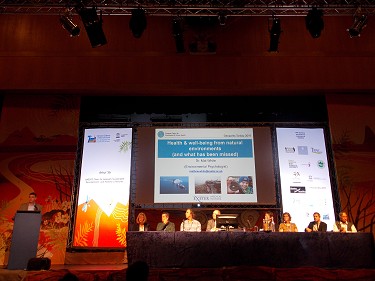
|
Wednesday 28.09.2016
The
Conference programme proposes a plenary session during the first part of
the morning. The issue in discussion is "Health and Wellbeing through
Creative and Active Engagement". Several experts participate with
key notes and own contributes. |
|
|

|
Wednesday 28.09.2016
In the
afternoon, Dr. Irina Pavlova (Unesco - Division of Ecological and
Earth Sciences)
introduces the panel discussion about
"Disaster Risk Reduction at Unesco Global Geoparks,
ways forward". |
|
|
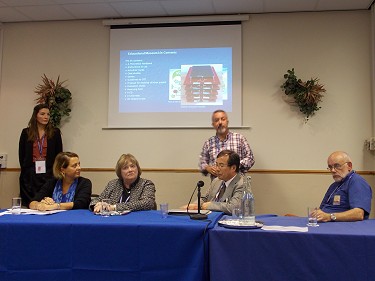
|
Wednesday 28.09.2016
The panel discussion table is
composed as follows; from left to right:
Irina Pavlova (Unesco), Alessia Amorfini (geopark manager of the Apuan
Alps Regional Park), Suzette Kimball (director of the United States
Geological Survey), Setsuya Nakada (volcanologist - Earthquake Research
Institute, University of Tokio), and Richard Watson (geopark manager of
the Marble Arch Caves - Northern Ireland).
|
|
|
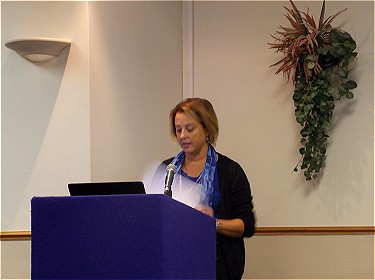
|
Wednesday 28.09.2016
Dr. Alessia Amorfini faces two different topics.
During the panel discussion, she presents "Rains and Ruins: twenty
years ago in the Apuan Alps”. This is the storyboard of the special
exhibition on the dramatic 1996 Flood in Versilia and Garfagnana, which
is scheduled for winter 2016 and spring 2017.
“Do not gamble on Earth tremble” is the title of her
second contribute during the following workshop on the earthquake risk.
These presentations are written by herself with Antonio Bartelletti, Giuseppe Ottria
and Emanuele Guazzi.
|
|
|
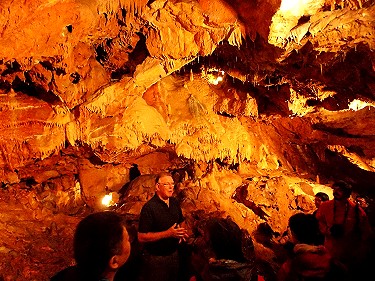
|
Thursday 29.09.2016
Field trip day... finally...
We suggest a possible title: "Cave & Cove"...
The first stop is into the Kents Cavern: the most important prehistoric
cave in Britain. This archaeo-geosite shows some concretions, but
its value is especially due to oldest dated hominid bones that were found
here. |
|
|

|
Thursday 29.09.2016
An impressive stone face captures the attention of the visitors.
Archaeologists found Roman coins inside wrinkles and folds of this face, maybe
with the meaning of religious offerings. |
|
|
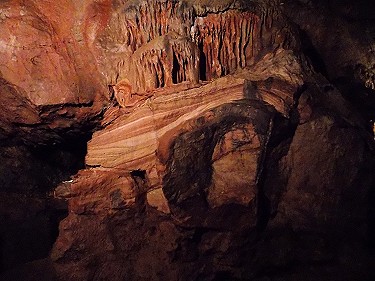
|
Thursday 29.09.2016
At the center of the picture a cutted stalagmite marks the
original cave floor before the archaeological escavation of the
underlying deposits.
|
|
|
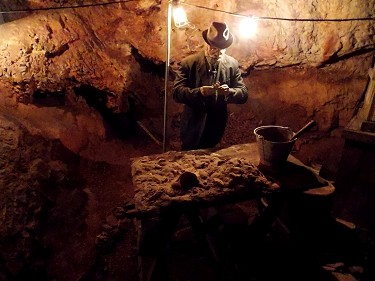
|
Thursday 29.09.2016
Kents Cavern is a real "show cave".
This perfect reconstruction of the archaelogical work remembers us the
scientific activity of William Pengelly (1812-1894) and his method of
cave escavation that is almost still in use today. |
|
|
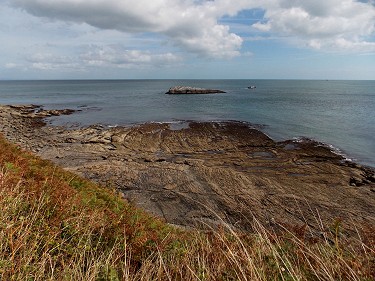
|
Thursday 29.09.2016
From the underground to the surface...
The second stop of the field trip is at Hope's Nose, north of
Tor Bay. This geosite shows a large outcrop of light-grey massive
limestone, with stromatoporoids and corals of Middle Devonian age.
Hope's Nose and other areas of Tor Bay (Triangle Point, Dyer's Quarry,
Long Quarry Point, Berry Head, etc.) were exploited to provide "marble"
during the nineteenth century. |
|
|
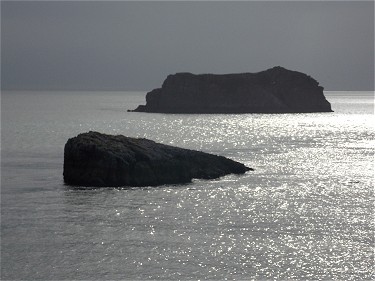
|
Thursday 29.09.2016
Lead Stone and Ore Stone, two little islands made of Devonian limestone near
to Hope's Nose. |
|
|

|
Thursday 29.09.2016
Dr. Kevin
Page (Lecturer in Earth Sciences - University of
Plymouth) guides the geologists group towards the stromatoporoid bank
exposed on rock platform. |
|
|
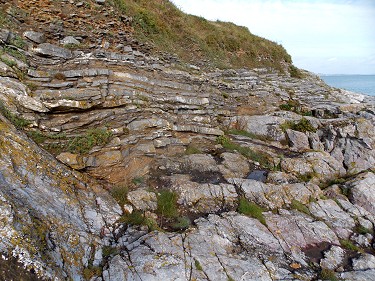
|
Thursday 29.09.2016
Also this short succession of thin-layered limestones tells us a complex
geology of thrusts, faults and folds. |
|
|

|
Thursday 29.09.2016
Thamnopora is a typical fossil of the ancient Devonian tropical seas. It
belongs to the tabulate corals (today extinct) that were common forms of
anthozoans.
|
|
|

|
Thursday 29.09.2016
A typical view of stromatoporoid-rich limestone on Hope's Nose. |
|
|

|
Thursday 29.09.2016
The Devonian
fossils of Hope's Nose are not only corals and sponges, but also
gastropod molluscs.
|
|
|
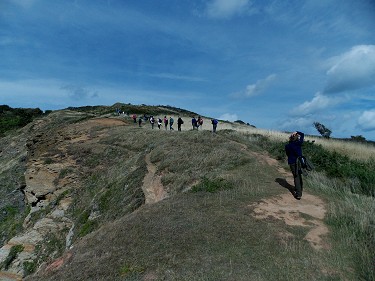
|
Thursday 29.09.2016
The geologists group climbs a long and windy route, trought a
semi-natural landscape after the crop abandonment. |
|
|
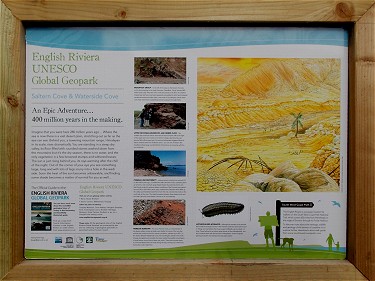
|
Thursday 29.09.2016
This panel - created by
English Riviera Geopark - explains the geology and
paleontology of Saltern Cove and Waterside Cove, last stop of the field
trip. |
|
|

|
Thursday 29.09.2016
The geologists group admires the beautiful stretch of exposed red cliffs. |
|
|

|
Thursday 29.09.2016
The train passes at the top of the cliff.
This is one of the finest heritage steam railway journeys anywhere in
Europe. |
|
|

|
Thursday 29.09.2016
Overturned fold in the sandstones and siltstones of the Meadfoot Group (Lower
Devonian) in
Saltern Cove. |
|
|

|
Thursday 29.09.2016
Ripple marks are present in the back limb of the same anticline. |
|
|
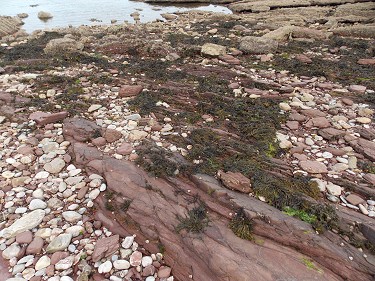
|
Thursday 29.09.2016
During low tide, the emerged rocks show different vegetal and
animal forms of intertidal life.
|
|
|
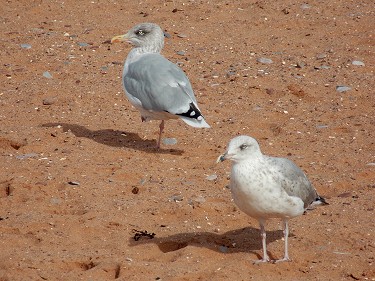
|
Thursday 29.09.2016
Herring Gull (Larus argentatus) is a common bird along the red
beach of Saltern Cove. In the picture, two different
individuals: juvenile (2 years) on the right and non-breeding adult on
the left. |
|
|

|
Thursday 29.09.2016
This red sandstone had aeolian origin in a dry desert (Lower Permian).
In the picture, you can see (near the coin) strange elongated and
rounded structures with parallel curved layers of small stones. It is
probably the burrow of a giant millipede, up to at least 1 m long. |
|
|

|
Thursday 29.09.2016
Roundham Head Breccia (Lower
Permian) overlaps on the Meadfoot Group sandstones and slates (Lower
Devonian). This unconformity marks a gap (hiatus) of about 130 million
of years. |
|
|
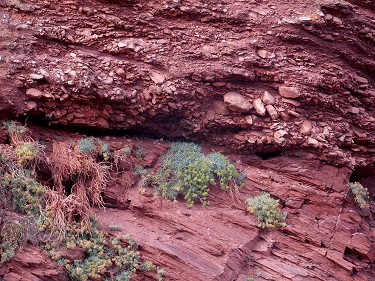
|
Thursday 29.09.2016
A detail of the previous
picture better shows the characteristics of the same unconformity as an
angular unconformity.
|
|
|
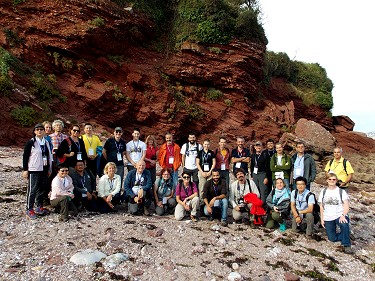
|
Thursday 29.09.2016
The geologists group in
the final souvenir photo with the unconformity in background. |
|
|
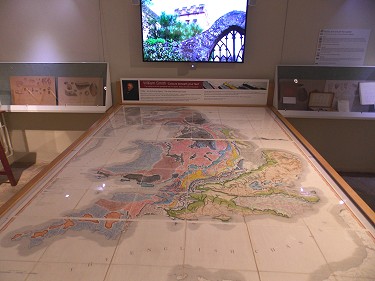
|
Friday 30.09.2016
In the morning, a quick
visit to the "Strata, the Earth in colour" exhibition on the
occasion of 200 years since the publication by William Smith (1769-1839)
of the first geological map of England and Wales, with part of Scotland. |
|
|

|
Friday 30.09.2016
In the afternoon, Dr.
Alessia Amorfini is the chairman of the session 10, theme 2: "Aspiring
Geoparks". |
|
|

|
Friday 30.09.2016
In this session, Dr. Edoardo Dellarole presents "Towards a regional
Unesco District - the Piemonte strategy". |
|
|
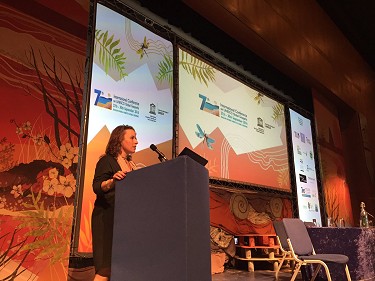
|
Friday 30.09.2016
Closing Cerimony in the Forum Hall of the Riviera International
Conference Centre.
Melanie Border (English Riviera Geopark Coordinator) reads the final
declaration focusing some topics: earth, community, peace, sustainable
development, georisks reduction, etc. |
|
|

|
Friday 30.09.2016
A great surprise for the Italian Geoparks Forum...
Adamello-Brenta has been voted as host of the next International
Conference on Unesco Global Geopark that will held in September 2018... |
|
|
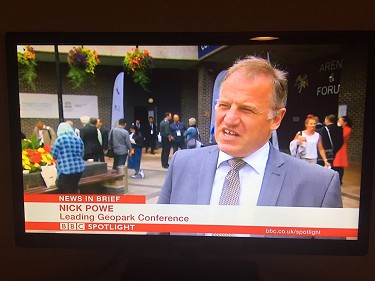
|
Friday 30.09.2016
7th International Conference has been a successful initiative that has
achieved a great media response. |
|
|
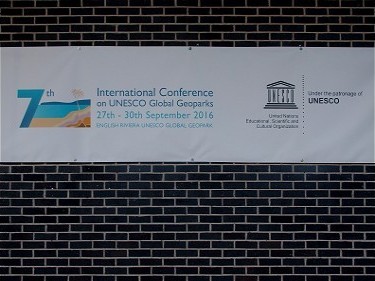
|
Friday 30.09.2016
7th International Conference was attended by 700 delegates from 63
countries. |
|
|
|
|
|
|
 back to Conference page
back to Conference page |
|
|
|
|
|
|
|
















































